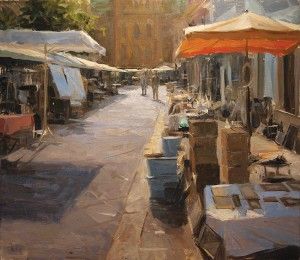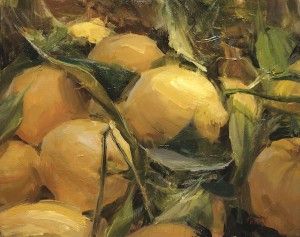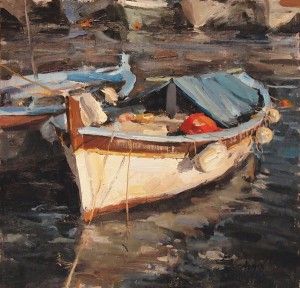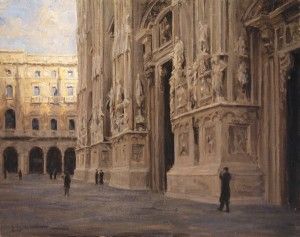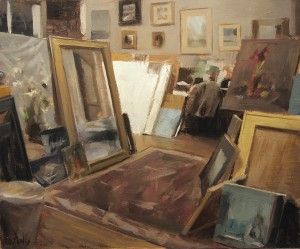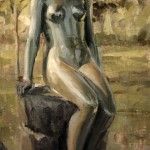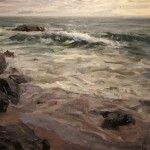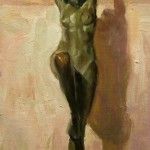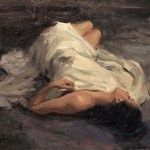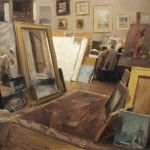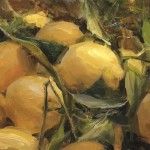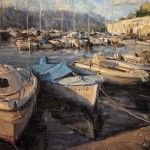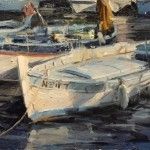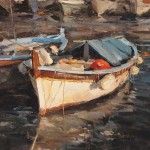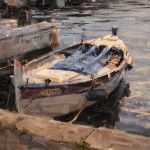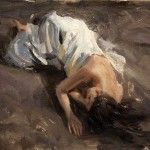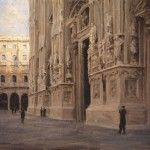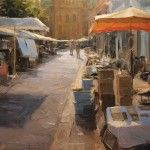Derek Penix discovers what drives his remarkable talent in art
By Gussie Fauntleroy
This story was featured in the October 2012 issue of Southwest Art magazine. Order the Southwest Art magazine October 2012 print edition here, or purchase the Southwest Art magazine October 2012 digital download here. Or subscribe to Southwest Art magazine and never miss a story!
Sometimes to go forward in life, you have to step back. Derek Penix would not have wanted to hear that when he was 19 years old and suddenly found that, without much effort, his painting sales “just started happening.” He wouldn’t have wanted to hear it a few years later when, out of the blue, an art publishing company flew him to California from his hometown of Tulsa, OK, and offered him a contract to produce 12 paintings a month.
But when the blush of instant success wore off, when the naïveté of youth gave way to dawning insight into himself and the art world, when the true satisfaction of painting started to emerge—that’s when stepping back and starting over, in a sense, propelled him forward like a shooting star. Now 31, Penix (pronounced Pen-nicks) is an award-winning artist still on a full-time track with painting. It’s just a different, more authentic track from the one he was traveling three years ago.
Ever since childhood, Penix has seemed destined for a creative path. Born into a family with a strong aesthetic appreciation for art, antiques, and the beauty of architecture in Tulsa’s historic neighborhoods, he was collecting old furniture by the time he was a teen. “People thought it was weird,” he concedes, his friendly, thoughtful personality coming through in a soft southern drawl. Penix’s grandfather could often be found refinishing antique furniture in his garage and was a painter on the side. His homemaker mother also painted and generously encouraged her son to pursue a career in art.
“I remember Mom always had a painting going. When I was a baby she was doing a giant painting, and I went up to it and slapped the wet paint and completely ruined it,” the artist relates, smiling. By his midteens he was full of self-taught notions about how to paint. Once, when he informed his mother that she was going about a painting the wrong way, she allowed him to paint over what she had just done. The result was not a masterpiece, Penix admits, but the incident stands out for his mother’s confidence in his artistic ability. That confidence would later help launch his painting career.
In 2001, during a visit to Laguna Beach, CA, with his father, Penix found himself in galleries unable to stop staring at certain still lifes. Struck by the abstract qualities contained within them, he remembered noticing a similar approach in the work of impressionist and Tulsa native Leonard Wren, whose art he had admired back home. To an artistically naïve young man, this aspect of painting was a revelation. “I was floored and mesmerized, because when I got up close I could see the brushwork and abstract qualities, but when I stood back, there was the three-dimensionality,” he recalls. Gazing at the still lifes, he suddenly realized, I can do this!
Back in Tulsa, the 19-year-old set up and photographed a still-life arrangement. Painting from the photos, he “jumped right into it.” More still-life and figurative pieces followed, and he took photos of azaleas in a nearby park and painted those. One day he and his mother were in a gallery close to their home when his mother struck up a conversation with the director. “My mother said, ‘You should see my son’s paintings!’ And I’m like, Mom!” His mother insisted he go home, sign his paintings, and bring them back. With the signatures still wet, he showed them to the director. She wanted them in the gallery. Almost immediately, they began to sell.
When Penix looks back at his paintings from his early 20s, he smiles wryly and describes them as “pretty-pretty and trite, the kind of art I can’t stand now.” Clearly he had natural talent, but with no formal instruction and with no real understanding of what draws the eye of fine-art collectors, he found himself caught up in the superficial world of painting for the market. In 2006 he married, and the wedding took place in France. From photos he took during that trip he painted numerous lovely, clichéd scenes. These caught the eye of an art publisher, who saw dollar signs in the paintings as mass-market prints. Penix lasted a year with production-line painting before burning out. He was laid off as both the economy and his love of painting started to skid. At the time it was a devastating turn of events. Ultimately, however, the experience provided valuable perspective and helped reinforce his determination when he finally steered onto a more appropriate artistic path. That direction came in the form of acclaimed Denver-based painter Quang Ho.
In 2010, Penix signed up for a three-day workshop with Ho, knowing nothing about the artist. A gallery director had suggested names of painters who led workshops, and Penix chose Ho’s because it was in Denver, where his parents had recently moved. The moment he walked into the studio and saw Ho’s paintings, the young artist was blown away. “Quang had paintings of subjects I would not have thought could be beautiful—like a painting of dead fish—but they were beautiful,” he recalls. Not “pretty-pretty,” but a compelling kind of beauty he instantly recognized as true art. “It really got me ultra-excited about painting,” he says. Likewise, by the end of the workshop Ho was excited about something he saw in the young man—a misdirected but significant talent more than ready to understand, and put into practice, what painting is really about. After the workshop, Penix called Ho a few times with questions, and Ho invited him to his studio to observe and talk while Ho painted. Both artists were stunned by the rapid changes in Penix’s art.
“I have never seen a transformation in an artist in such a short amount of time,” Ho remembers. “I gave him everything I knew about what works in a painting—as I do with every student I teach—and he put it to immediate practice in a way that was quite amazing to me. By the fourth or fifth painting he showed me, I remember saying to him that he didn’t need me anymore. He had already made all the right decisions in the painting, which let me know he understood enough to intentionally have made those decisions. Sure enough, the paintings that followed were right on course. Derek is one to look out for,” Ho adds. “His work will go far.”
And so far, it has. Among Penix’s latest honors is the President’s Award of Excellence at the 2012 Oil Painters of America National Juried Exhibition in June. The award went to DUOMO DI MILANO, an eloquently quiet moment in the shadow of Milan’s dramatic Gothic cathedral. Other recent honors include Best of Show in the October 2011 BoldBrush Competition, for ANTIQUE MARKET IN FRANCE. The backlit market scene in Nice represents an important step in Penix’s development, as he began to more fully exercise his “artistic license” in terms of color and form. “It was one of the first paintings where I started to bring out the abstract by simplifying shapes and altering colors for more color harmony,” he explains. “It’s one of the first where I was able to change what I was seeing, rather than copying what I saw.”
The element of abstraction in representational painting, which thrilled Penix when he encountered it as a teen, still fuels his drive to continually move forward in his own work. In his newly built studio in a historic section of Tulsa, furnished with antiques he has collected over the years, the artist creates still lifes, interiors, and figurative art. His wife, Catherine, whom he met when she worked as a painting model, remains the primary model for his figurative works. Inspired by the art of Richard Schmid, Penix increasingly employs an a la prima approach, finishing an entire painting before the paint is dry. In recent months he has also been on a boat kick, as he puts it, exploring the possibilities of color, light, and shape in a series featuring fishing boats. His boat paintings have garnered praise from artist C.W. Mundy, who says that Penix has “a brilliant sense of paint manipulation, color, and design.”
As Penix began putting into practice what he learned from Ho, he realized the painting lessons were important life lessons as well. When his only goal was marketability and money, he believed he needed to always be in control. Now he finds he can explore, experiment, and play with materials without becoming attached to the results. “What I discovered was: Don’t be afraid to mess up. Don’t overthink what you’re doing. If you get too attached, the painting goes downhill,” he reflects. “If you’re painting for the wrong reasons, you’re never going to do what you really want. But if you’re painting just for the unconditional love of it, and you don’t worry if it sells, or even if it’s good, then you’re on the right track.”
representation
Abend Gallery, Denver, CO; Dodson Galleries, Oklahoma
City, OK; Meyer East Gallery, Santa Fe, NM; Waterhouse Gallery, Santa Barbara, CA; Elizabeth Pollie Fine Art, Harbor Springs, MI; derekpenix.com.
Featured in the September 2012 issue of Southwest Art magazine–click below to purchase:
Southwest Art magazine October 2012 digital download
Southwest Art magazine October 2012 print edition
Or subscribe to Southwest Art magazine and never miss a story!
- Derek Penix, Woodward Statue, oil, 20 x 10.
- Derek Penix, The Beach, oil, 20 x 24.
- Derek Penix, Statue at Philbrook, oil, 12 x 6.
- Derek Penix, Reclining Figure, oil, 11 x 14.
- Derek Penix, Quang Ho’s Studio, oil, 10 x 12.
- Derek Penix, Market Lemons, oil, 8 x 10.
- Derek Penix, French Harbor, oil, 20 x 24.
- Derek Penix, French Fishing Harbor, oil, 8 x 16.
- Derek Penix, French Fishing Boat, oil, 12 x 12.
- Derek Penix, Fishing Boat, oil, 12 x 12.
- Derek Penix, Figure, oil, 11 x 14.
- Derek Penix, Duomo di Milano, oil, 24 x 30.
- Derek Penix, Antique Market in France, oil, 20 x 24.
MORE RESOURCES FOR ART COLLECTORS & ENTHUSIASTS
• Subscribe to Southwest Art magazine
• Learn how to paint & how to draw with downloads, books, videos & more from North Light Shop
• Sign up for your Southwest Art email newsletter & download a FREE ebook






